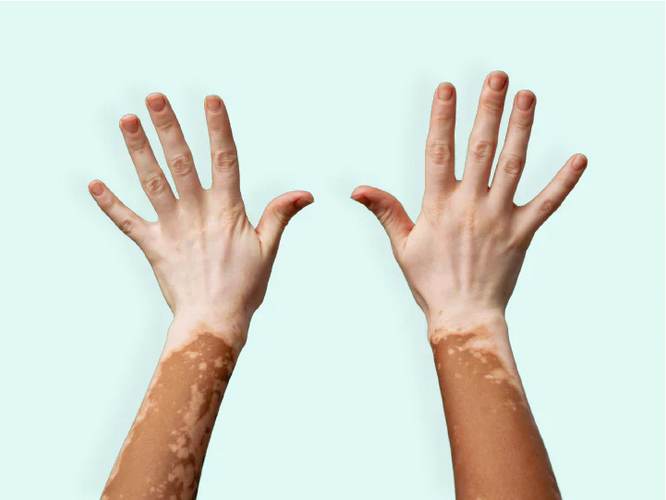Vitiligo causes your skin to lose color or pigmentation. Smooth white areas called macules or patches appear on your skin, which generally starts on your hands, forearms, feet, and face. Globally, about 1% of the population has vitiligo. If you don't like changes into your skin tone or hair colour. You can use a treatment. Neofollics for example, offers a treatment that can help restore the natural colour of your hair and prevent greying hair. 
Anti Grey Hair Treatment
Vitiligo can also cause premature grey hair on the head, eyes, or face. It is an autoimmune skin condition in which immune cells destroy melanocytes, the cells that produce pigments called melanin in your skin. When these cells are destroyed, white patches appear.
In this article, we will explain the causes of vitiligo, its symptoms, its effects on the skin, and its effect on your hair.
What is vitiligo?
Vitiligo is a chronic autoimmune skin condition in which immune cells destroy melanocytes, the cells that produce pigments called melanin in your skin. When these cells are destroyed, a pale or white patch of skin can result.
Vitiligo can appear at any age and run in families. Often vitiligo is more visible in people with darker skin tones, because of the contrast in the unaffected areas of skin.
Michael Jackson and Vitiligo: A Famous Connection
Vitiligo gained worldwide attention through the late pop icon Michael Jackson, who openly discussed his battle with the condition. Jackson's journey with vitiligo was both inspirational and educational, shedding light on the challenges and emotional aspects of living with this skin condition.
What causes vitiligo?
The exact causes of vitiligo are not yet fully understood, but it is believed to be an autoimmune condition. In autoimmune diseases, the immune system mistakenly attacks and destroys healthy cells within the body. In the case of vitiligo, immune cells target melanocytes, the cells responsible for producing the skin pigment called melanin. When these melanocytes are destroyed, the affected skin loses its color, resulting in the characteristic white patches.
Melanin of the hair or skin can be destroyed as a result of
- Autoimmune disease
- Genetics
- Environmental factors
- Toxins and chemicals
- Certain medications
Vitiligo Symptoms
Vitiligo typically manifests as depigmented or hypopigmented patches on the skin. These patches are often well-defined and can vary in size and shape. While vitiligo can affect people of all skin types, it is most noticeable in individuals with darker skin tones. The condition is not limited to the skin; it can also affect the hair, resulting in changes like premature grey hair.
Vitiligo itself usually does not cause hair loss. Vitiligo hair loss therefore is caused by some other condition such as alopecia areata or androgenetic alopecia. Fortunately, these hair loss conditions are possible to treat with Neofollics Hair Growth Stimulating Products. That promotes healthy hair growth and slows down the hair loss process. Vitiligo and alopecia areata share the same immune system pathways and are linked to an increased prevalence of thyroid autoimmunity and atopic dermatitis.
Conditions like Poliosis, or white forelock, can also cause grey or white patches in your hair. They are similar to vitiligo and can occur with conditions such as alopecia areata. A skin biopsy might be needed to diagnose the exact cause of pigment loss.
Some products are believed to trigger vitiligo, including:
- Deodorants
- Disinfectants
- Insecticides
- Latex
- Synthetic oils
Does Vitiligo Affect Hair?
Yes, vitiligo can affect hair, leading to changes such as the premature greying of hair on the head, eyebrows, eyelashes, or even facial hair. This is a direct result of the immune system's attack on melanocytes. When melanocytes are damaged, the affected hair may lose its natural color, turning grey or white. In hair, this means that you can develop a condition commonly known as “vitiligo white hair”.
Treat Vitiligo
While there is no cure for vitiligo, several treatment options are available to help manage the condition and potentially restore some pigmentation to the affected areas. These treatments aim to repigment the skin, reduce the contrast between depigmented and pigmented areas, and improve the overall appearance. It's important to consult with a dermatologist to discuss treatment options tailored to your specific needs.
Conclusion
Vitiligo, an autoimmune condition affecting about 1% of the population, causes depigmentation in the skin and can lead to premature greying of hair, often referred to as "vitiligo white hair." Understanding the intricacies of vitiligo empowers individuals to make informed decisions about their well-being. Vitiligo often goes together with alopecia areata, which is a hair loss condition and is difficult to treat, but slowing down hair loss is possible with an effective treatment.










